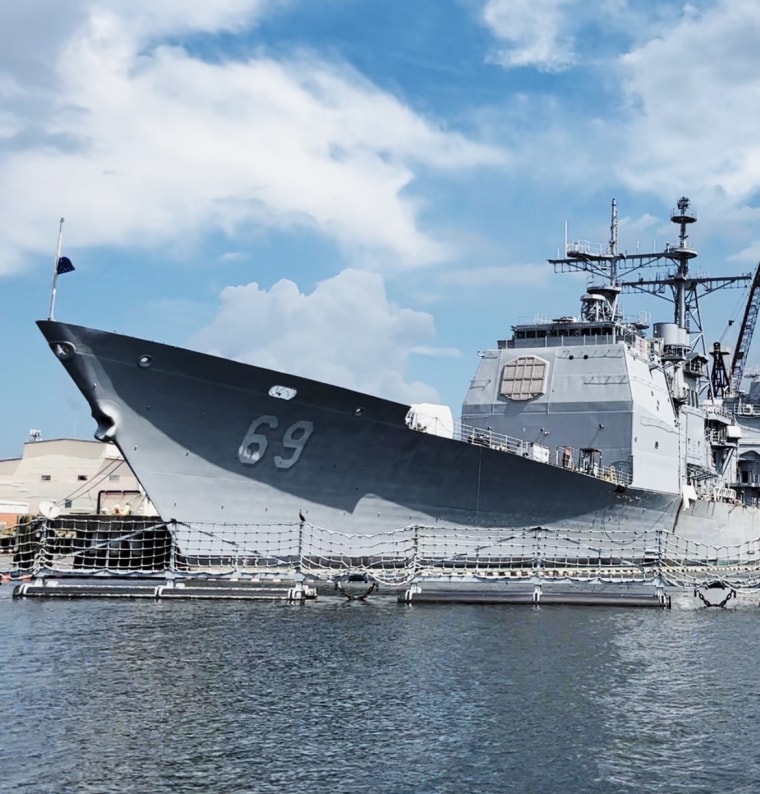For more than six years, the USS Vicksburg has sat idle at a shipyard in Norfolk, Virginia, undergoing repairs that have cost U.S. taxpayers hundreds of millions of dollars. Yet the 567-foot guided-missile cruiser might never return to sea. The USS Vicksburg is one of 11 vessels that the Navy is seeking to retire but members of Congress may not let it.
“I’m sure most taxpayers look at the situation and say, 'No, this is not acceptable,'" Diana Maurer, the director of defense capabilities and management for the Government Accountability Office, or GAO, said. “Why are we spending money on a ship that was supposed to be modernized, that is not modernized, that is currently not sailing and may never sail again?”
The Vicksburg's long and costly ordeal highlights the Navy's struggle to modernize its fleet as China seeks naval supremacy in the Pacific. A different ship, the USS Boise, a nuclear attack submarine, has been under repair for eight years.
“It is unacceptable,” Navy Adm. Lisa Franchetti said about the Boise this month at her Senate confirmation hearing to run Naval ship operations. Franchetti cited lack of manpower at shipyards as contributing to the delay.
Maurer's office released a report this year that found the Navy is spending more money repairing its warships while its vessels are spending less time at sea. From 2011 through 2020, operating and support costs across 10 ship classes grew by $2.5 billion, or 17%. That included a $1.2 billion increase in maintenance costs – a 24% jump, according to the GAO report.
Maurer said the rising maintenance costs are due in part to the Navy's having put off the upkeep of the ships when they were involved in combat in the wars in Iraq and Afghanistan.
“Similar to your car, if you don’t do the necessary or the recommended maintenance on your car, you’re going to save a few hundred dollars this year, but next year when your transmission goes, when your brakes no longer work, when your engine fails, you’re going to face a much higher price tag," she said.
Mauer said a lack of spare parts and unfilled jobs also contributes to ships languishing at shipyard ports.
In response to questions from NBC News, Secretary of the Navy Carlos Del Toro said that “we will continue to review the material conditions of the ships, hull by hull, to ensure we extend the service life of ships, when possible.”
“Continuing to spend money on legacy systems that do not contribute to our advantage in strategic competition is not a smart or effective use of taxpayers’ dollars,” Del Toro added

Each year, the Navy sends Congress a list of ships that officials want to decommission or retire. In March, the Navy submitted to Congress a list of 11 ships it sought to retire, including the Vicksburg.
It wasn't the first time the Vicksburg appeared on the list. But it hasn't been decommissioned because of opposition from lawmakers.
Members of Congress often object to a ship's retirement because the repair work means jobs at shipyards in their district. Others oppose the decommissioning of a ship for another reason: They want the Navy to maintain a high number of ships in its fleet regardless of their condition in order to deter China.
The Navy currently has a goal of 355 ships but has maintained a fleet of 270 to 300 battle force ships since 2003, according to the Congressional Research Service.
Most of the ships on this year’s retirement list, like the Vicksburg, are more than 30 years old. But two of the ships are just seven years old and part of the troubled Littoral Combat ship class that has been sharply criticized by watchdogs for wasteful spending.
The USS Vicksburg was first launched in 1991.
While the Navy has spent at least $175 million on its contract with BAE Systems, which operates the Norfolk shipyard, to modernize and repair the Vicksburg, the total cost of maintenance is likely much more.
At a House Appropriations Committee hearing last year, Chairwoman Kay Granger, R-Texas, said that the Navy had awarded $500 million in contracts to update the Vicksburg. The Navy says that total cost includes “various availabilities, material procurements, and advanced instillations,” but it declined to say how much of the $500 million has been spent to date.
Despite years of repairs, Rep. Rob Wittman, R-Va., still objects to decommissioning the Vicksburg. But he said he's now resigned to the ship’s fate.
"I’m not in favor of it, but I think it’s a fait accompli," Wittman said. "I think it’s one of those courses that we’re going to have to take. It’s a tougher argument to put that much money into that ship where we could take the same amount of dollars and put them into multiple other ships and get more service life out of them."
A BAE Systems spokesperson said in a statement that "we continue to work under contract with the Navy to achieve its desired outcome for the USS Vicksburg."
Senators have begun to describe the maintenance delays in dire terms.
“I think it’s time for a hair-on-fire task force on this issue," Sen. Angus King, I-Maine, said at a Senate Armed Services Committee hearing this month.
"We can improve productivity at those facilities. But looking at the numbers, it just doesn’t seem like that will be enough."

